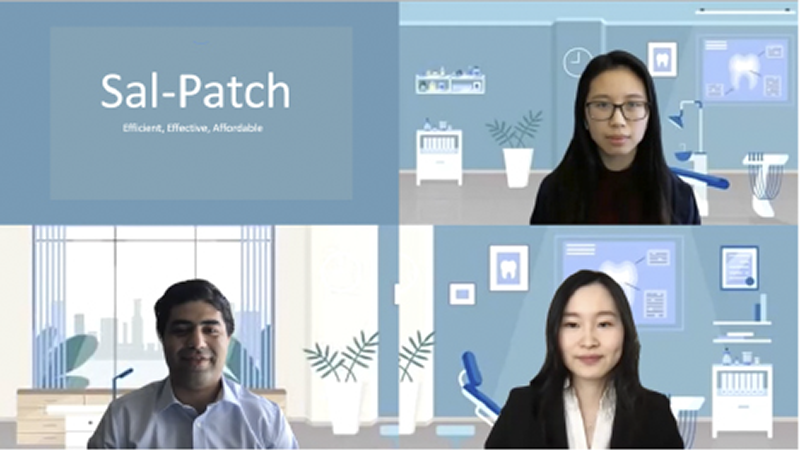UCLA Engineering Student Research Team Wins UC Big Idea Contest

Image credit: Sal-Patch Team
The Sal-Patch Team: Crystal Xiao (top right), Madhi Hasani and Cher Zhang (bottom left to right).
The research group consists of bioengineering graduate students and fellow lab members — Xuexiang (Cher) Zhang and Crystal Xiao, as well as Mahdi Hasani, an assistant project scientist at the UCLA Samueli School of Engineering. Song Li, professor and chair of the Bioengineering Department, is the lab director and faculty advisor on the project. The team created a low-cost, periodontal-microarray patch that can be used to treat periodontitis.
Periodontitis is a common, destructive inflammatory disease that afflicts more than 50% of adults in the United States. According to the UCLA team, Sal-Patch is a first-in-class periodontal patch based on biodegradable microarrays with prolonged drug release. Microarrays allow local penetration into the gum tissue and engineered particles ensure prolonged release of therapeutic drugs over the course of weeks. Sal-Patch is designed to repair receding gum lines and reverse bone degeneration caused by periodontitis.
In November 2020, students from across the University of California system submitted a record number of innovative ideas to the UC Big Ideas Contest. More than 900 graduate and undergraduate students, representing every UC campus, submitted 354 applications addressing a wide range of important social challenges, which is what drew the Sal-Patch team to enter.
Modulation of the local immune environment has always been a common interest shared among the team members. The group focused on periodontitis because of its chronic and inflammatory nature with involvement of many immune cells.
“The Big Ideas competition was a unique opportunity due to their focus on social impact,” said team lead Zhang who is expected to get her Ph.D. next year. “We felt that our product had huge potential to help others, so the Big Ideas competition was a natural fit.”
The researchers chose to focus on a low-cost treatment for periodontitis, as they have personally experienced how inadequate early dental education, particularly in low-income communities, is associated with the disease.
“We saw how debilitating the disease was, and we would like to improve people’s quality of life by finding an affordable cure that is accessible to all,” said Zhang.
“The disease is so prevalent that many people, including our close family members, were affected,” Zhang said. “We saw how debilitating the disease was, and we would like to improve people’s quality of life by finding an affordable cure that is accessible to all.”
Because of the local, precise delivery to gum tissue, the researchers said the drug amount required to achieve the same therapeutic effects would be much lower compared to systemic drug delivery via oral administration. In order to minimize the cost of biomaterials, the team focused on scaling production of microparticles and microarrays. Considering the small amount and size of each dental patch, the cost per patch is under $1. In addition, the prolonged release of drugs from Sal-Patch makes it unnecessary for repeated and frequent patch replacement.
The team was selected as one of the finalists in May and plans to use the $5,000 award to continue developing its product. Through the competition, the group made connections with industry advisors, who the researchers say have been invaluable to their growth as a startup. They are financially supported by the National Institute of Dental and Craniofacial Research C-DOCTOR program for technology development and preclinical studies — an ongoing arrangement for which they report their progress every six months to the National Institutes of Health organization.
In addition to their win in the Big Ideas competition, the group also received first prize in the Regenerative Medicine category at the LA Bioscience Ecosystem Summit Twenty21 Conference.
As they continue to develop the research and design behind Sal-Patch, the budding entrepreneurs are still learning how to market and scale Sal-Patch. “As researchers, the business side is new for us and understanding the setup for a successful company is something we’re still learning,” Zhang said. Nevertheless, the team said they learned a valuable lesson transforming a lab research concept into a real-world solution.
“It is the vision behind the product that makes us excited and motivates us,” Zhang shared. “A product needs to have a soul and as we learn more about our product’s potential, we’re dreaming big and have a vision, which is to provide an affordable solution that reverses periodontitis. The accessibility of our product will help people in need just like our family members.”
The team, along with bioengineering Ph.D. candidate Tyler Hoffman, also recently won second place in UCLA Easton Technology Management Center’s Cross-Campus Innovation Challenge for another creation — a vaccine booster, BioMatVax. A biomaterial-based vaccine adjuvant platform, BioMatVax boosts vaccine-induced immune activation that can lead to long-term immune memory for SARS-CoV-2 and other viruses. The team is working on the booster’s clinical and commercial translation.
Chloe Slayter contributed to this story.
